Review Rundown: The One With A Bollywood Wedding
No, really. Okay, kinda. Eleven Reviews, including Knott’s Scary Farm, Pipilotti Rist at LA MOCA, and more.
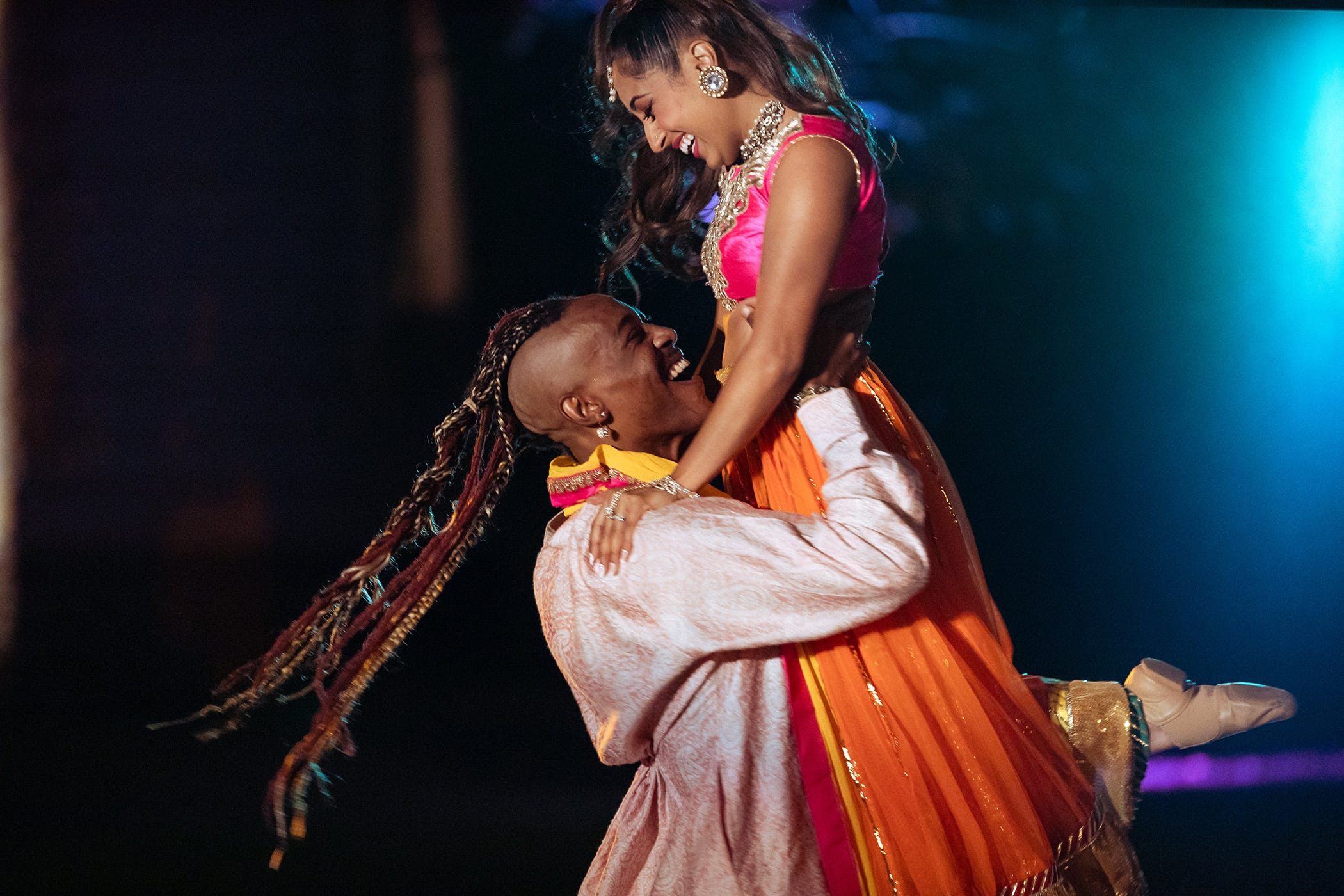

Eleven reviews. Art. Horror. Site-Specific Dance. Theatre. Online experiences. THERE IS NO TIME LET’S GOOOOOO.
Are you a creator who looks upon these reviews with jealousy? OK, the positive ones from last week, at least? Then you might want to check out our How To Get Covered By NoPro guide, which we just updated for the first time in ages.
More From The Review Crew
- The REVIEW CREW podcast recording is every WEDNESDAY in our Discord: next recording is on 9/21/21 at 5:00PM PDT.
- Dive into Last Week’s Review Crew show.
- Check out the most recent Pick of the Week on the current episode of
The All-New NoPro Podcast. - Last week’s edition of the Rundown is right here.
- The next Pick of the Week will be announced in the Friday podcast drop.
Subscribe to our podcasts via Patreon for bonus content or find us ANYWHERE podcasts are found for the core ’cast: Apple Podcasts, Google Podcasts, Audible, Amazon Music, Stitcher, Spotify, and even YouTube!
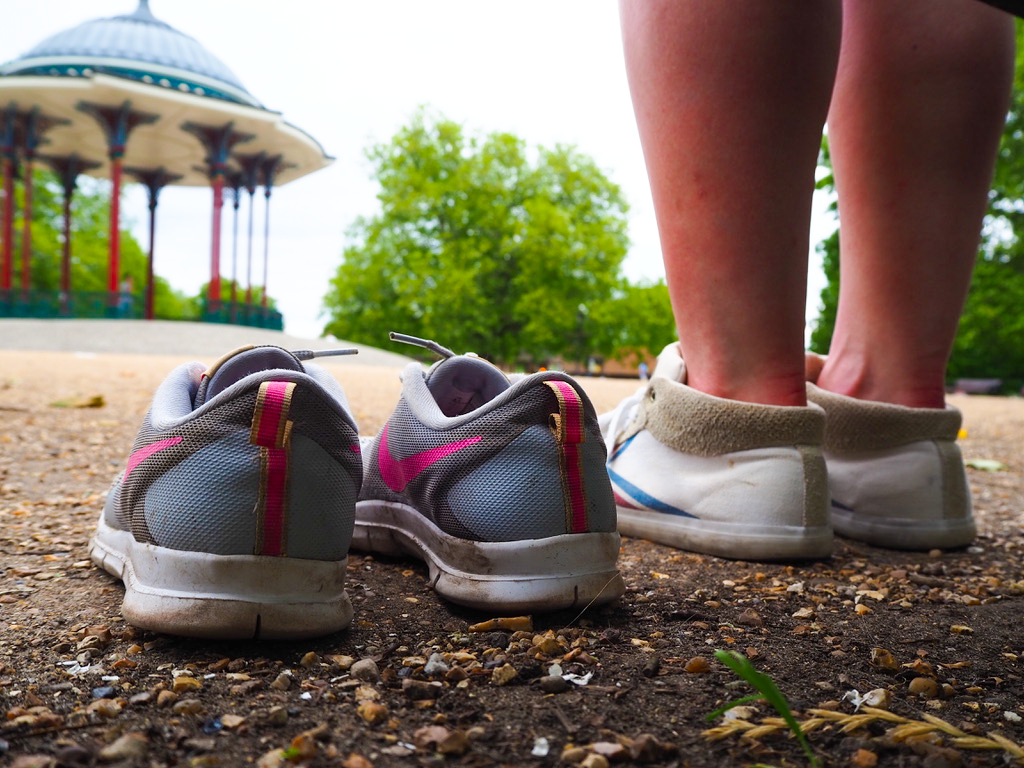
A Walk in the Park — Fast Familiar; presented by Tender Absence
€4; Remote (Podplay); Through Oct 31
The sun is out, warm and bright. The park is filled with people, milling about on paths or sitting on the grass relaxing. When on a walk, I’m usually alone save for my thoughts. But not this time. With headphones on, I listen to a companion talk. They’re sharing not only the sights and sounds of their park but also heady thoughts on how parks are not without their share of danger.
Part of Tender Absense’s online festival, A Walk in the Park by Fast Familiar is a podplay experienceable in any public park, though ideally a large and crowded one. For roughly 30 minutes, A Walk in the Park prompts me to perform specific actions or ponder particular thoughts as I walk. The podplay is a well-executed, gratifying experience. The sound design is top notch, with the artificial park soundscape that’s playing in my ears seamlessly blending together with the natural one. The narrative’s pacing is well-timed as I’m never rushing to keep up. I’m able to relax and be taken on this journey, which is a rare occurrence I greatly appreciate.
Yet the message and intention fueling A Walk in the Park leaves me feeling adrift at my journey’s end. The podplay was created in response to the murder of Sarah Everard, who went missing in a park — one which several Fast Familar company members live near. There’s a repetitive, heavy-handed (but incredibly vague) allusion to a “her” with no tangible or broad details ever included. Everard’s murder is the center of which A Walk in the Park revolves around, but that purposeful intention is not successfully conveyed on the walk itself.
This frustrating cloud of missed opportunities looms large over A Walk in the Park. I spend more time thinking about the production and narrative design afterwards rather than the important and unfortunate reminder of remaining vigilant and aware in public spaces, especially in those designed for everyone’s enjoyment.
— Patrick B. McLean, Chicago Curator
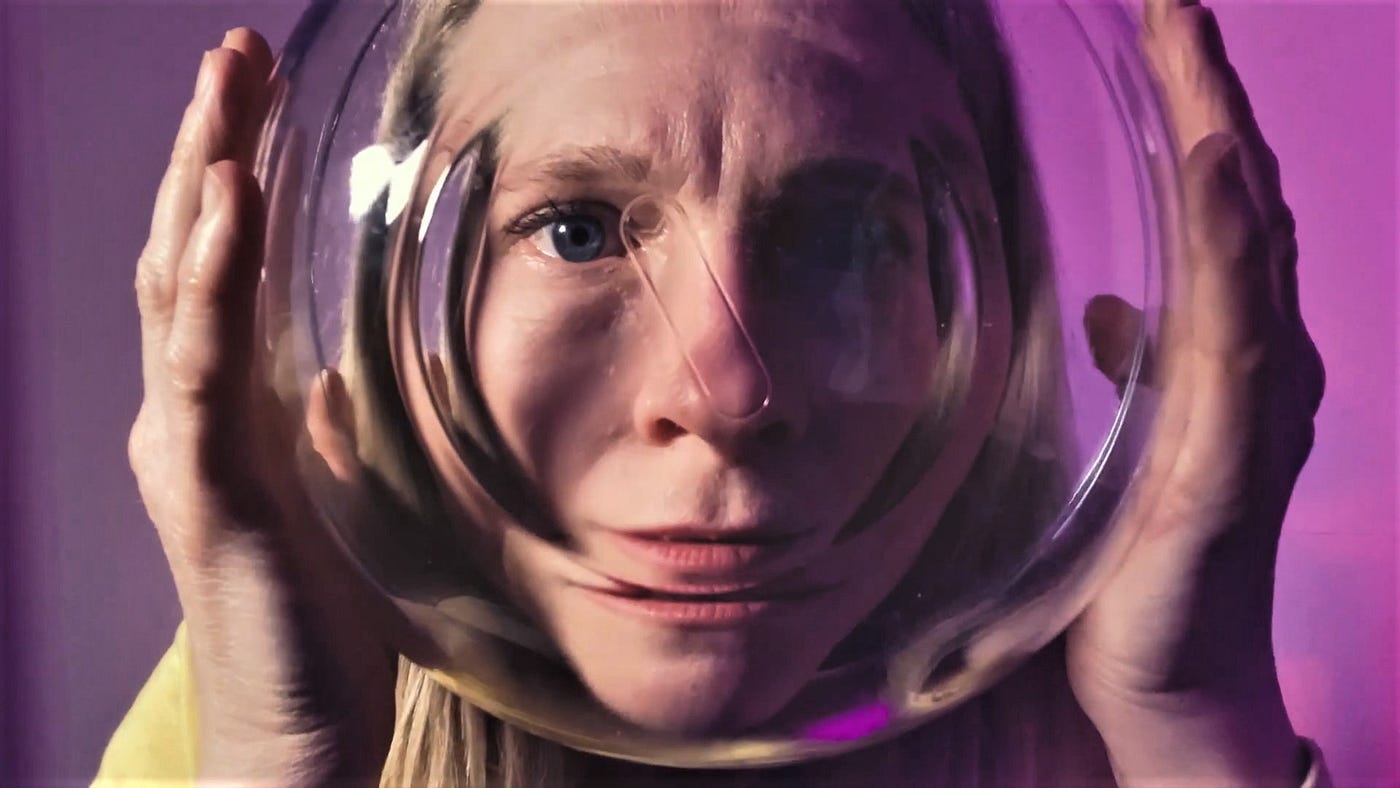
Blueprints — Lobster Frock
£15.00; Remote (Website); Through Oct 14
A certain phrase escapes me for describing when an object of quality is obscured by something that even on its own would be grating. Perhaps we could say the prize at the bottom of the raisin bran box? (Apologies in advance to the few lovers of raisin bran I know.)
Looking at Blueprints, an online choose-your-own adventure by Lobster Frock, I can’t help but need that phrase which I can’t quite recall. Buried within Blueprints are some of the loveliest and most tender performances. From the same artist, we get both a side-splitting satirical rant on the grandiosity with which we address the birth process as well as a heartbreaking reflection on the artist’s mother as she succumbs to dementia. From another performer, we hear stories of the ways her own mother filled her life with wonder and unreasonable pressures. When considered as an evening of short monologues on a common theme, presented creatively, Blueprints is uniformly superb. (If you choose to participate in the experience, I strongly recommend hunting for the stories marked by bowls and by knives.) But what a mass of, er, “raisin bran” to dig through, though.
I found the choose-your-own adventure aspect feels like a series of choices divorced from the common theme. After installing a somewhat cumbersome browser plug-in and watching a meandering intro video, I was asked if I was confused. When I said yes, I was met with assurances that I should be confused. Hunting for links to the stories you want to hear, which remain invisible until you hover over them, is a chore here, as is the mandatory 30 second waiting time before you’re allowed to even begin hunting. And while the symbolism of navigating a dollhouse (the metaphor of the interface) is somewhat connected to themes around mothers and daughters, nothing deeper is done with it.
I do understand the desire to add an immersive or interactive element to more involve the audience in a piece. But, in the case of Blueprints, these elements served only as a speed bump in my ability to connect with something already beautiful.
— Blake Weil, Curator at Large, East Coast
Delirium: The Devil’s Instrument — Andrew Novick, Claire Voyant,
Dirty Duvel, Hagbard Celine, and Polka Dottie
$50 per table for two; Denver, CO; Through Oct 31
Checking in at the door of a nondescript music venue, I receive a skeleton key and am told to wait to the right. I’m greeted by a woman in a dark Victorian dress who I follow to the bottom of a stairwell, deposit my key in a tray, and follow through a curtain into a low lit parlor. After ordering a themed cocktail and letting my eyes adjust, my friend and I catch up while waiting for the rest of the 30(ish)-person party to arrive. Soon, it’s announced that Violet, the Lady of The Manor, is arriving. Soon after, we meet Violet’s sister-in-law and begin to wonder where Victor, Violet’s husband, might be.
The scene ends abruptly, with a sneaking suspicion that something might be amiss, but with no idea where the story is going. The manor’s servants deliver each table an ultraviolet “torch” with which we’re invited to look around the parlor during the first of two 15-minute intermissions. The walls are full of curiously weird and beautiful art installations in a variety of mediums — projection, mixed media collage, photography, sculpture — with violins being a recurring theme throughout.
The remaining two acts use repetition to build suspense and lean into the state of delirium that the experience’s name suggests you will encounter, each loop adding more confusion and madness. While three loops feels like a tease (five would have been perfect), it’s still an effective approach to creating a sense of deliriousness for the audience.
Delirium is promoted as “part themed pop-up bar, part art installation, part performance,” and it’s important to keep that in mind, as nearly half of the 80-minute experience consists of downtime during which you’re expected to explore the world and look at the art. Regard it not as a “show,” but as a curated social experience to get you in the mood for Halloween.
— Danielle Look, Denver Correspondent
Knott’s Scary Farm 2021
Starting at $50; Buena Park; through Oct. 31
I was born in Orange County and my second theme park was Knott’s Berry Farm. Even though I eat Knott’s Strawberry Preserves pretty much every day of my life and am not above begging for a lifetime supply on the Internet, I’ve never been to Knott’s Scary Farm. That and I’ve got a bone to pick with how Knott’s is handling the whole “deadly pandemic” thing.
But let’s get some praise going before I get to the beef:
The new Mesmer maze is FREAKING AWESOME. After going through six of the other eight mazes and only really being impressed by 2019’s Origins — which is PRETTY DARN AWESOME thanks to its very clever use of existing Knott’s infrastructure — I stepped out of Mesmer buzzing. I could go on at length, but I’ll save that for a podcast.
What kills me, though, is how lax Knott’s is about masks. I get it: they’re in Orange County. It’s a whole cultural battle there. But you know what sucks? Canceling other plans because you feel weird (i.e. sinus stuff and muscle aches) a couple of days after going to an amusement park and making sure you get a Covid test before seeing anyone else because you don’t want to be the asshole who got someone’s kid sick because a theme park is babying the very people who are dragging this stupid pandemic on into its 18th month here in the United States. Or is it 19th? I’ve lost track. This could have been over in six weeks if people weren’t being clowns about it. They’re not even knife wielding clowns! (Scary Farm has plenty of those. They’re adorbs.)
Anyway: I wish I could just be all WHEEEEEE! I LOVED SCARY FARM PLEASE SEND ME PRESERVES & FRIED CHICKEN NOW.
Instead I spent the weekend playing “flu shot reaction or COVID?” Maybe if there had been an actual gin joint at the end of the Gore-ing 20’s interactive streetmosphere track (which was pretty fun, again: the creative team is killing it; um, phrasing?), I’d be less cranky about it. The test came back negative, and the symptoms subsided. So the good news is I’m not getting anyone killed this week. Not soon enough for me to un-cancel my plans, though. I’m not even one of the more high strung people I know about this stuff, I’ve just got family to protect. If that’s you: do not go. If you don’t care: YOLO, I guess. I know I won’t be back this year. Which is a shame, because two times through Mesmer wasn’t enough, but it’s not worth another Covid test. Maybe next year, if we’re not on month 30 then.
— Noah “I Was Born In OC, I’m Not Gonna Die There” Nelson, Founder & Publisher

Lovers and Madmen: Visions of a Midsummer Night’s Dream
— Forgotten Lore Theatre with Lone Brick Theatre Company
$20.00; Philadelphia, PA; Run Concluded
There are ideas in the world that feel so blisteringly obvious once executed, that one can only seethe with envy that they didn’t think of it first. It is with this pleasurable envy I look upon Lovers and Madmen, a production of A Midsummer Night’s Dream that gets its audience hopelessly, deliriously lost in an actual forest.
With uniformly strong if not truly exceptional performances, Lovers and Madmen did an admirable job adapting Shakespeare’s comedy. I will say that certain character decisions worked better than others: Theseus as a sexist tyrant made slightly more sense than Peter Quince as a vulgar sex maniac. Additions of characters from other works such as Ariel and Hecate (from The Tempest and Macbeth, respectively) were equally mixed and ultimately didn’t tie in with the themes of the central story.
The environment and direction, though, dazzled the audience without fail, elevating Lovers to something special. Each scene pulled the audience deeper into the woods of Widener University’s Taylor Arboretum. By the time Bottom the Weaver is enchanted, there were no signs of the mortal world anywhere to be seen. Nature is hard to “fake” convincingly but I’ll say this much: there is no substitute for an actual glen decorated in twinkling lights. Moments, such as when I was pulled on stage to dance among the fey, were enhanced by the glow of fireflies and the clean smell of early Autumn. Interludes between primary story beats separated the audience on diverging paths, confusing and disorienting us. We heard the lovers call to each other from different sections of the forest, occasionally darting in front of us before running back into the woods; the attention to blocking gave a kinetic energy to verse that can often come across as stodgy to modern audiences.
While not groundbreaking in its interpretation of the text, Lovers and Madmen provided its audience with a visceral experience of the story. And its innovations in staging make this show a delightful last breath of summer, one I’ll remember as we head into the darker months of the year.
— Blake Weil, Curator at Large, East Coast
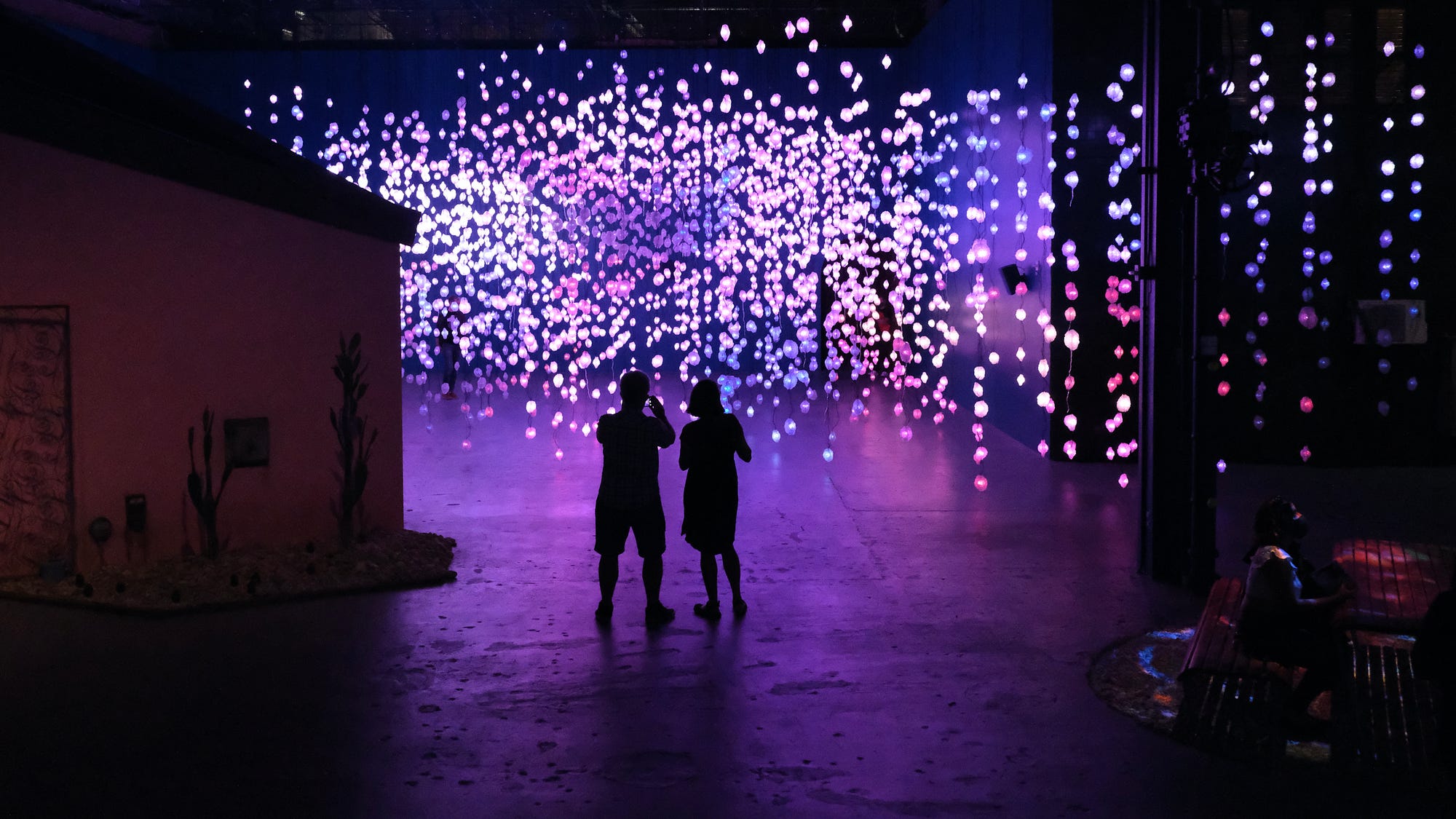
Pipilotti Rist: Big Heartedness, Be My Neighbor — Pipilotti Rist
$0 — $18; Los Angeles, CA; Through June 6, 2022
I sat at my kitchen table, a picture window to my left. I’d just returned from Pipilotti Rist’s new exhibition at the Museum of Contemporary Art. In my periphery, I had a worming sensation. I turned towards the window, waiting for the image to distort in the same vein as Rist’s videos: to undulate, bisect itself, or dilate into a micro view of the bamboo stalks outside. I’d become so absorbed in her perspective that I had transported that peculiar lens into my own home; as odd and unexpected as this was, it reflects a fundamental goal of Rist’s art.
Get No Proscenium’s stories in your inbox
Join Medium for free to get updates from this writer.
SubscribeSubscribe
Pipilotti Rist: Big Heartedness, Be My Neighbor is the Swiss artist’s first West Coast retrospective, which includes pieces from the 1980s as well as new work. The multimedia show immerses viewers into her (often playful and sensuous) explorations of liminality, portals, and worlds within worlds. Large-scale installations recreate domestic environments and participants are encouraged to step inside these intimate spaces, both literally and metaphorically, to share confidential moments with others. Videos, Rist’s anchor medium, are embedded throughout the exhibition.
Rist’s work challenges our shared constructs around private versus public, the familiar versus the foreign, and fantasy versus reality. She invites viewers to abandon their sense of separateness, to explore the membranes of our lives — whether actual or perceived — and to peer, with humor and empathy, at our thoughts, identities, corporal selves, and surroundings without cellular divide. The exhibition is her realization of museums as “shared apartments where you can visit each other’s brains and bodies.” Especially after a year of feeling housed within our constraining digital window frames, Rist’s work inverts our viewpoints; the result is a personal, subjective experience instilled in the surreal, universal magic of life.
— Laura Hess, Arts Editor
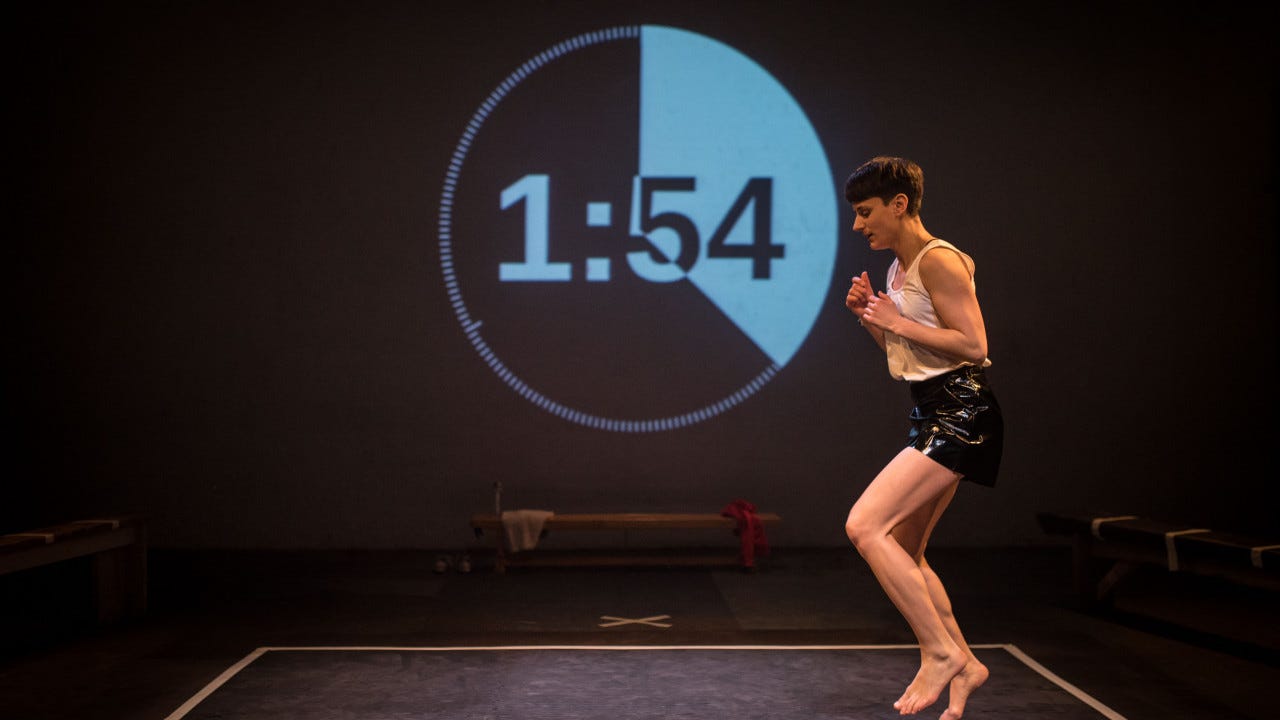
Run Club — Ira Brand, presented by Tender Absence
€ 4.00; Remote (Zoom); Run Concluded
When I first booked this show, I was a little nervous because booking an outdoor running-themed show at 11:30am in Southern California is a dicey proposition. Then, I saw that the weather looked perfect, but some nagging aches and pains threatened to derail my plans. Still, I laced up my shoes, determined to at least try to run along with Run Club for as long as I could.
And I’m so glad the weather and my body decided to cooperate.
Produced as part of Tender Absence’s lone|some series, Run Club is a solo audio show that asks you to “travel” with creator/performer Ira Brand as she goes on a run and offers a meditation on running. Brand speaks more generally near the beginning, musing on the body, the movement of that body, and how taking her exercise, her movement, and turning it into a show blurs lines between work and other parts of her life. It was thought-provoking stuff, and added a layer to my run as I considered how I had let the line blur in this instance.
Brand’s thoughts on running were where the piece most deeply connected with me. A few minutes into the show, there were a few moments of eerie synchronization; she asked me to breathe in and out, and then our breathing came together; she suggested a right turn, just as I made that turn myself. One of those was intentionally designed, but the other synchronous moment was a fun coincidence. That wasn’t the end of the synchronization, though. As Brand explained what running meant to her and why she did it, it felt like her voice was literally in my head, rather than just my headphones.
I might have felt our alignment in the idea of making eye contact with other runners and exchanging nods in solidarity (I said it out loud to the empty street, and to Brand, at the same time). Or it might be in the idea that she runs to lose herself. Or it might also be in the idea that she runs to feel, because it eliminates the need for words. Maybe all of these thoughts are contradictory, but they’re true to why I run, too. She talked of running to find out what she is — and that’s a big existential question — but a question which I’ve found different answers to over and over again. I find them when I lose myself in the perfect runs, the bad runs, the hard runs, and even the runs I didn’t want to go on.
In one sense, it felt like I was in a deep but silent conversation with Brand about running. In another, it was like hearing my inner voice and thoughts on running made real. It would have been unsettling if it also hadn’t felt so natural. And it was so natural that when she addressed me as a stranger near the end of the performance, I tried to explain to her and the empty street that we weren’t strangers. It felt like we, in some ways, did know each other. But alas…
If immersive theatre is, in part, about finding a connection, that was exactly what Run Club provided: a connection to running, to a runner halfway across the world, and to myself.
— Kevin Gossett, LA Reviews Editor
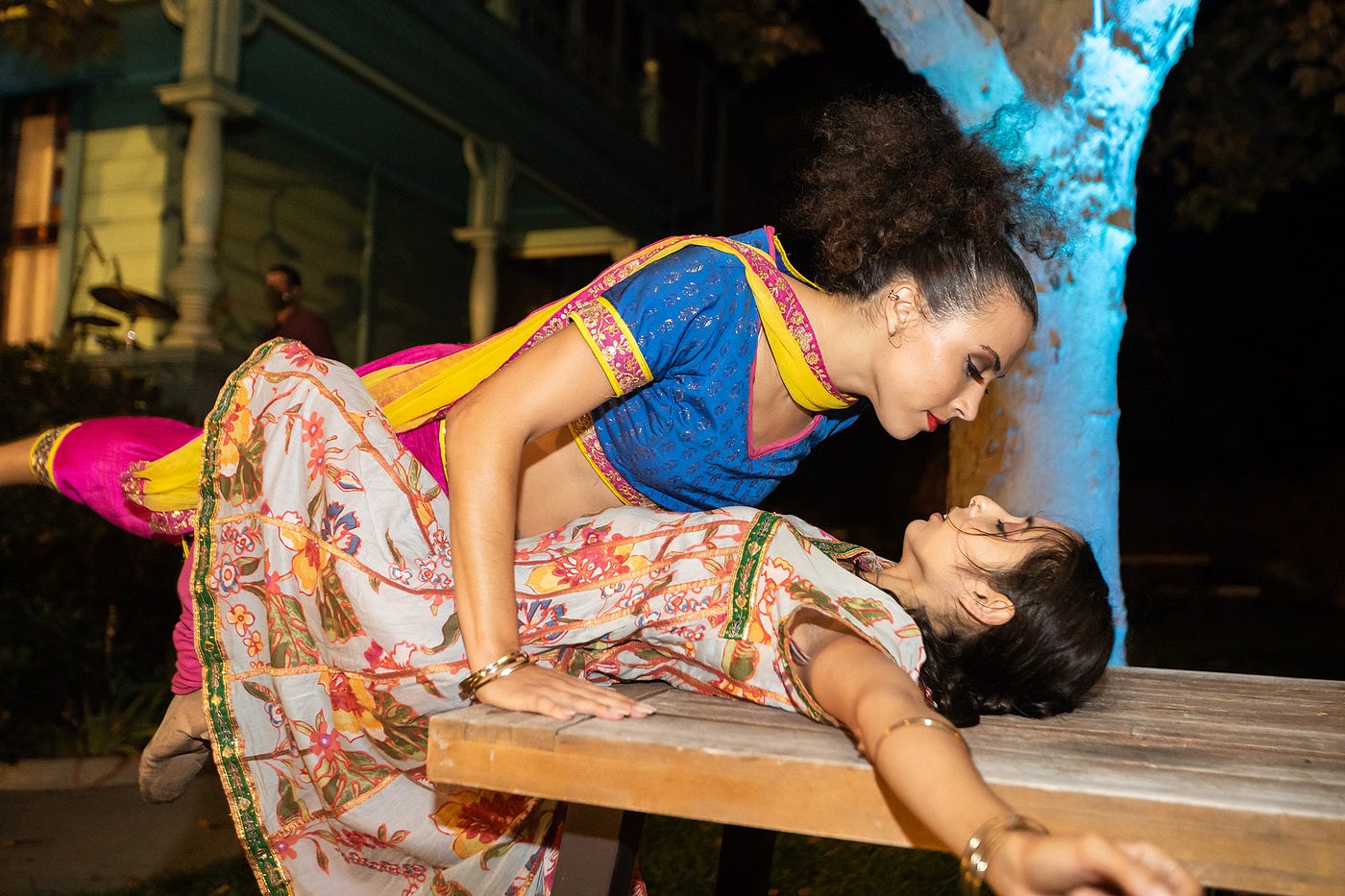
Shaadi — Blue 13 Dance Company
$10–75; Heritage Square Museum, LA; Run Concluded
Blue 13 Dance Company’s Shaadi is a powerhouse of a dance theatre production that transforms the hodgepodge Victorian “neighborhood” of LA’s Heritage Square Museum into an evening long Bollywood romance, complete with spurned lovers, forbidden romances, a wedding and, of course, dancing, dancing, dancing.
As a work of site-specific dance theatre, few pieces in LA have come up to the standard that the first third of Shaadi does. The ensemble cast is ridiculously skilled, from the bit players to the leads. There’s a raw, unfiltered magic to their talent that Artistic Director Achinta S. McDaniel and Associate Artistic Director Jon Paul hone through their choreography into a keen edge. Each number, on its own, is a dynamic feat of expression that made me wish I could watch the pieces over and over to pick up the subtleties. (I got to do this with one piece and did not regret it.)
Where Shaadi struggles is in the glow up gap between site-specific and fully immersive work. With the audience given largely free reign to wander after the opening third, some of the energy raised up and channeled by the company dissipated as soon as the production shifted to a sandbox-style that the Heritage Square Museum grounds invite, but aren’t quite equipped to handle when the crowd is a hundred or more people.
This meant the middle of Shaadi was treated by some patrons as a kind of extended intermission. Meanwhile, others tried to cram into spaces that couldn’t quite contain all of those who wanted to see the exquisite pieces taking place inside the historic homes of the Museum.
A final sequence that cycled the audience into groups, those inside the church — for a breathtaking piece of work that is set in part to Billie Eilish’s “GOLDWING ”— and those outside dancing with the cast, confused my companion enough to think the show was over prematurely. It wasn’t, but there were four rotations, so I can forgive those who thought the same.
These missteps weren’t enough to crash the party vibe, thought. The dancing itself flies so high and the storytelling is there if you, like me, have a nose for melodrama and an eye for dance theatre narrative. I do find myself hoping that Blue 13 brings the same degree of care to choreographing the audience experience as it does to the dances themselves next time. I’m talking in the MACRO sense: not just letting the audience “in ”on the dance numbers but shaping how they move through the space. (That combination gets me dizzy and giddy to think about because I’m pretty sure they can pull it off and make it memorable in the process.)
In any case: I’m a fan now.
— Noah Nelson, Founder & Publisher
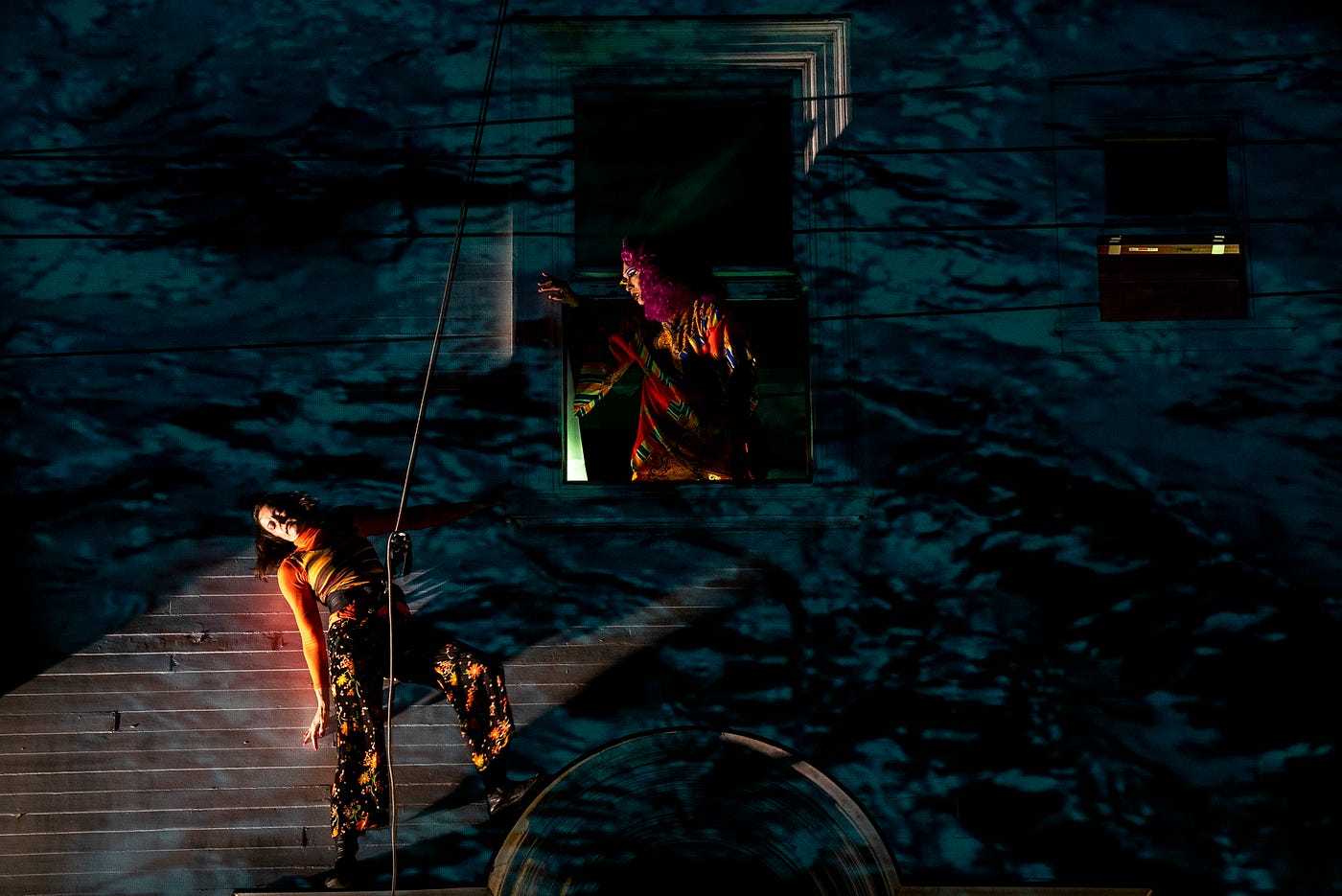
Time of Change — Joe Goode Performance Troupe
with San Francisco Heritage
$20.00-$48.00; San Francisco, CA; Run Concluded
As the sun sets in the Panhandle of Golden Gate Park, a crowd gathers with their phones and earbuds in anticipation of an audio-enhanced walking tour through the infamous Haight-Ashbury neighborhood. We stand together in a calm green space, the narrow oasis surrounded on both sides by the roar of city traffic. The city wanted to tear down this space to expand the street. But the neighborhood banded together to protect it. We’re reminded that this is the stolen land of the Ohlone people. We stand at a crossroads of generations who have made this space their home: those who have lived and died, those who loved and suffered, and those who have produced soaring works of beauty and committed unspeakable atrocities.
We are split into three groups, occasionally passing and integrating with each other. Some performers are familiar, some we see only in passing — much like the residents of a neighborhood, sharing a space and flitting into and across each other’s lives. Throughout the tour, we come across beautiful tableaus and dance performances, punctuated with music, poetry, and narration of the residents who have called Haight-Ashbury home. The piece’s themes of sexuality, spirituality, sensuality, identity, race, and family explore the utopian dreams and setbacks of the hippie revolution and the neighborhood at large.
The journey culminates on Haight Street, as the previously landbound performance suddenly takes flight. Musicians appear on a rooftop and a crushingly beautiful rendition of “If You’re Going to San Francisco” fills the streets. With every window exploding with performers, the building glows with projection mapped video. Performers take to the sky as aerialists dance along the walls of the buildings; the streets come alive and the line between reality and performance is blurred.
Time of Change is at once an exploration of the neighborhood and an interrogation of what it means to be a community. It simultaneously celebrates the history of the space, indicts those who committed the sins of the past and the sins still ongoing, and asks the big question of what has it all meant. The performance does not offer easy answers, but those questions will linger long after the next generation of those who gather on the intersection of Haight and Ashbury Street.
— Brian Resler, San Francisco Bay Area Curator
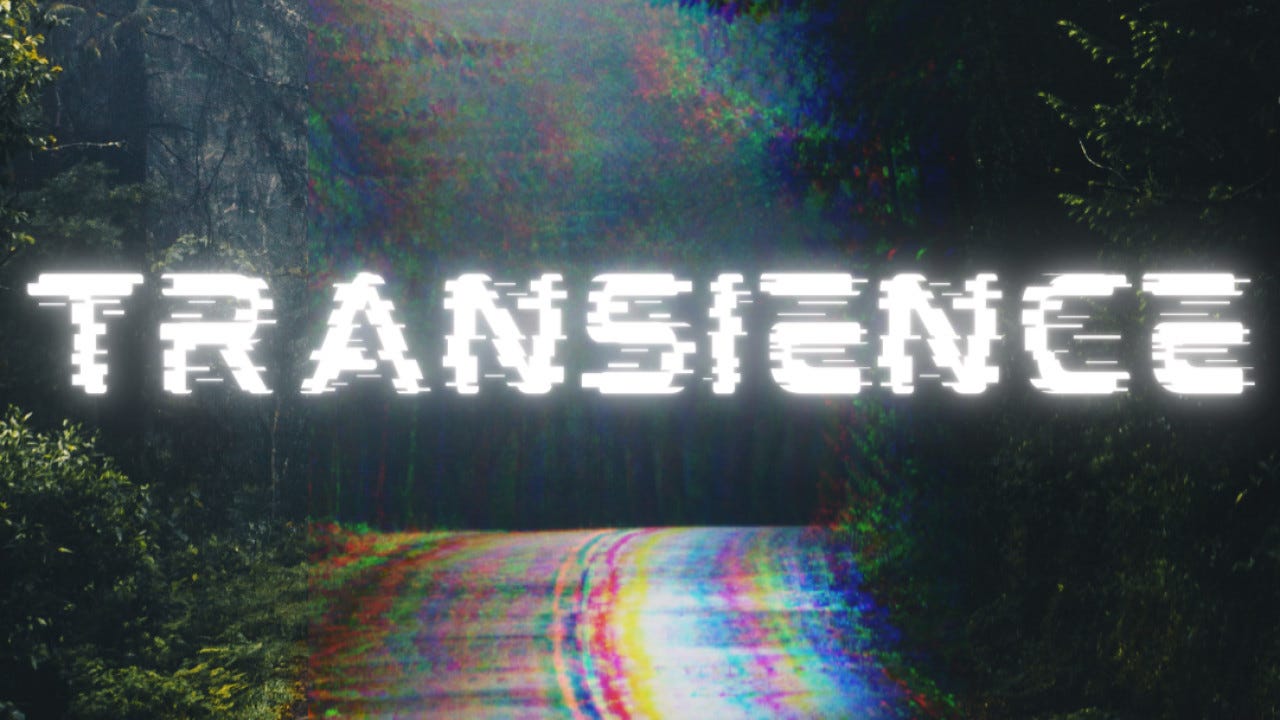
Transience — Hitcher Encounters, presented by The Tank NYC
$30; Remote (Phone Call); Ends October 3
There’s a scene from Inception in which Elliot Page’s character describes the “pure discovery” of architecting dream worlds. Transience, by Hitcher Encounters, offers a similar experience for audiences. Through a one-on-one phone call, participants are enlisted to retrieve an artifact, co-designing their mission by answering questions fielded by the performer throughout the call. Little else is revealed beforehand and once the show begins, it launches with force.
The writing is witty and the pacing quick. At first, the volume of description was disconcerting because it was too much to track and I couldn’t identify which specifics were crucial to my mission. And yet, this initially uncomfortable layer added to the “sliding doors” aspect of the experience. As I relaxed into the auditory rhythm of Transience, I “watched” the descriptions like I might a film or video game. Without the option to “press pause,” I never knew if a particular detail could have been relevant to the mission I was crafting. Some questions presented simpler, binary choices. Others were more open-ended and extended moments of creative exploration. The production’s format pressurizes the experience: without time to ruminate over decisions, imagination is unconstrained and intuition takes over. This is what drives that sensation of pure discovery.
Transience embodies a reminder that our choices matter. In not only what did come forth, but also what didn’t: missed connections, uncaught opportunities, and paths not taken. We wonder about those unlived lives existing in parallel universes. Even during the show, I craved the chance to do it over again and make a different turn at each intersection, to more fully sate my curiosity to know those alternative narratives, with my desire to probe all options and who I could be in each of them.
— Laura Hess, Arts Editor
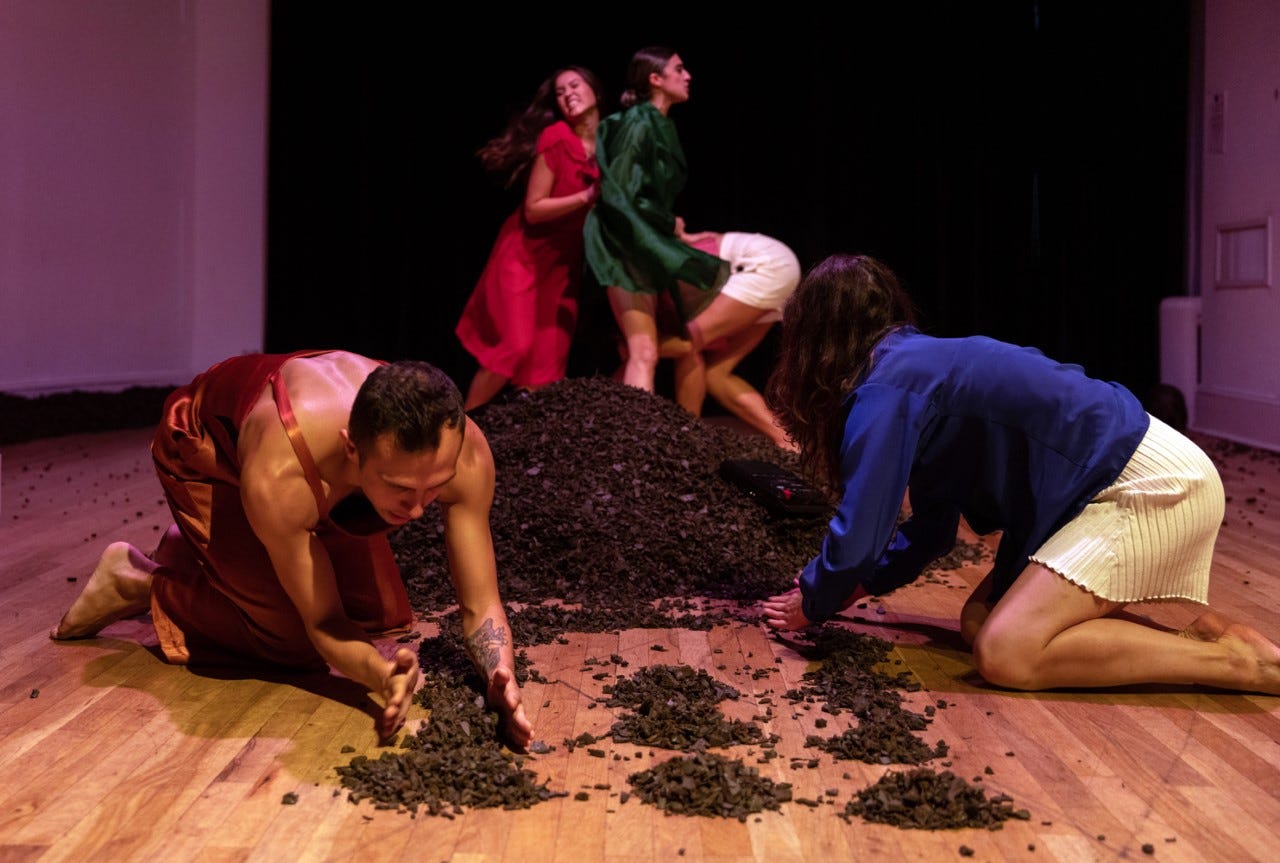
What Keeps You Going? — Holdtight
$50; New York, NY; Through Oct 2
In brightly colored clothes, clearly designed for dance, standing upon shredded black tires, a troupe of performers welcomes the audience to the space. A tape recorder is thrust towards me. “Why do you care?” someone asks.
What Keeps You Going? is described as an immersive dance piece taking place in the Cell Theatre, a townhouse converted into an experimental art gallery. This avant garde piece fits right in as the “liminal space between past, present and future” are all reckoned with during the show. But the experience has a hard time bringing the audience along for the ride without a cohesive narrative to latch onto.
I stared at screens filled with the eyes of our six performers, searching for meaning, but found nothing but their stares reflected back at me. All of the performances are dialed up for emotional impact, with tears and shouting, but not a lot of it actually lands with me. And no obvious story comes crashing over me. For a piece inherently about connection, there was no interaction with the audience at all. And at one point, I reached down to pick up a piece of tire, just to have a more tactile sensation. Additionally, I found that the movement itself in the piece didn’t relate to the unusual space around us; it really could have fit into any black box theatre space.
That said, I enjoyed an incredible musical soliloquy played for us by the hugely talented, Grammy Award-winning saxophonist Johnny Butler, as he stood hidden within a birdcage.
The performances were by and large excellent, make no mistake. But I found the immersion and overall purpose to be lacking. In a post-pandemic world, theatre has the opportunity to be therapeutic, even cathartic, but here I felt like I was experiencing chaos and uncertainty again, rather than moving forward with hope.
— Edward Mylechreest, New York City Correspondent
Discover the latest immersive events, festivals, workshops, and more at our new site EVERYTHING IMMERSIVE, new home of NoPro’s show listings.
NoPro is a labor of love made possible by our generous Patreon backers. Join them today!
In addition to the No Proscenium website, our podcast, and our newsletters, you can find NoPro on Twitter, Facebook, YouTube, Instagram, in the Facebook community Everything Immersive, and on our Discord.